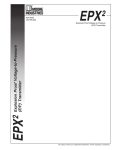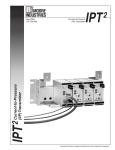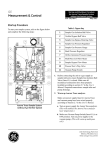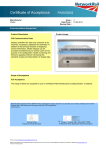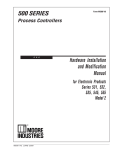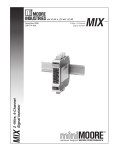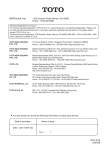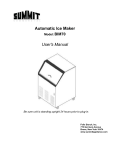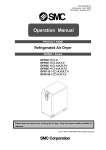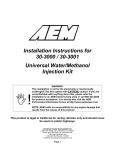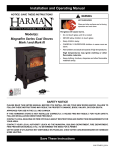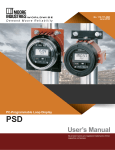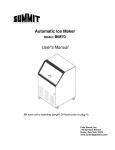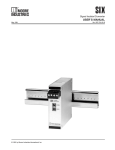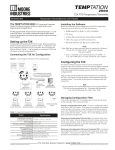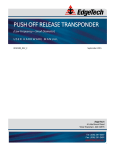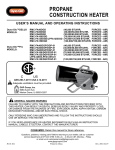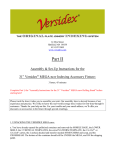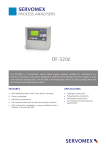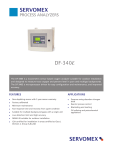Download Instruction Manual - Gilson Engineering Sales Inc.
Transcript
October 2002 170-755-00 A 2 IPH & IPX 2 2 IPH & IPX 2 Current-to-Pressure (I/P) Transmitters Current-to-Pressure (I/P) Transmitters All product names are registered trademarks of their respective companies. IPH 2 & IPX 2 Table of Contents Introduction ....................................................................................................... 3 The IPH2 & IPX2 .................................................................................................. 3 Specifications ................................................................................................... 3 Calibration ......................................................................................................... 4 Necessary Equipment .........................................................................................................4 Preparing for Calibration .....................................................................................................4 Calibration Process ............................................................................................................ 5 Installation ......................................................................................................... 8 Phase One: Mounting ......................................................................................................... 8 Phase Two: Electrical Connections .................................................................................... 8 Phase Three: Pneumatic Connections ...............................................................................9 Operation ......................................................................................................... 10 Maintenance .................................................................................................... 10 Troubleshooting the IPH2 & IPX2 .................................................................................................................. 11 Customer Service ........................................................................................... 11 Intrinsically Safe Diagram .............................................................................14 Product/Technical Descriptive Notice .........................................................15 2 The Interface Solution Experts IPH 2 & IPX 2 Introduction IPH2 & IPX2 This users’ manual for Moore Industries’ IPH2 and IPX2 Current-to-Pressure Transmitters contains all of the information that is needed to calibrate, install, operate, maintain, and troubleshoot this family of transmitters. The rugged IPH2 and IPX2 Current-to-Pressure (I/P) Transmitters are designed specifically for extended duty in harsh field environments. Meeting NEMA 4X and IP56 requirements, the IPH2 is watertight, dustprotected, and highly resistant to corrosion and chemicals. The extruded aluminum housing of the IPX2 (IP66, NEMA 4X) is explosion-proof and waterproof, making it perfect for most any location. The following guidelines are used in this manual: WARNING - Hazardous procedure or condition that could injure the operator. Caution - Hazardous procedure or condition that could damage or destroy the unit. Note - Information that is helpful for a procedure, condition, or operation of the unit. These 2-wire (loop-powered) transmitters convert a current signal to a pneumatic signal so that an electronic-based system such as a DCS, PLC, or PC can control a pneumatic actuator, valve, or damper drive. Available models accept a wide range of current inputs (4-20mA, 4-12mA, and 12-20mA) and provide a proportional pneumatic signal (3-15psig, 0.2-1Bar, 20-100kPA, etc.). Reverse pneumatic outputs are also available. Both units are available with an optional coalescing filter/regulator that combines an air filter and miniature supply line regulator with a pressure gauge that reads in both psi and Bars. Specifications Performance Accuracy: <±0.25% of Performance Air Consumption span including the combined (Continued) (Dead-ended): effect of linearity, hysteresis, At 3psig output, 20psig and repeatability (between supply, consumes 0 and 3psig output, error will 0.08SCFM (0.14m3/hr), not exceed ±1.0% of span) maximum; At 15psig output, 20psig supply, consumes Stability: Not to degrade from stated accuracy for six 0.10SCFM (0.17m3/hr), months maximum; At 15psig output, Step Response: <0.2 40psig supply, consumes seconds into 100ml load 0.15SCFM (0.26m3/hr), (6 in3) from 10% to 90% of maximum; At 30psig output, span; Not guaranteed below 40psig supply, consumes 3psig output. 0.17SCFM (0.29m3/hr), Supply Pressure Effect: maximum Negligible from 20-40psig, Maximum Input: 80psig steady pressure without damage for units with Air Capacity: output pressure rating of 5.0SCFM minimum (20psig >15psig; 45psig without supply, 0psig output) damage for units with output pressure rating of ≤15psig Relief Capacity: 2.5SCFM Voltage Drop: minimum (15psig output) 5V maximum Air Supply: Instrument air Mounting Position Effect: only, 20-40psig (Must be Negligible, unit can be 5psig greater than maximum mounted in any position; output) Should be mounted upright or Gas Supply with –NG1 or horizontal to keep water out if –NG2 Options: Same it is not in a dry environment cleanliness as instrument air. H2S not to exceed 20ppm Ambient Operating & Storage Conditions Range: -40°C to +85°C (-40°F to +185°F) Ambient Temperature Effect: <±0.025% of span/°C, maximum from -20°C to 80°C; <±0.1% of span/°C, maximum RFI/EMI Effect: <±0.1% of span change in field strengths of 10V/m @ frequencies of 20-500MHz Shock and Vibration Effect: Meets SAMA PMC 31.1 as detailed in the field mounted category Relative Humidity: 0-100%, non-condensing Adjustment Zero & Span: Screw adjusts zero or span by ±10% minimum, non-interactive Weight IPH2: 1.14Kg (2.5 lbs) IPX2: 1.95Kg (4.3 lbs) Specifications and information subject to change without notice. The Interface Solution Experts 3 IPH 2 & IPX 2 Preparing for Calibration Calibration Every IPH2 and IPX2 is fully tested and calibrated at the factory prior to shipment. However, before installation, your IPH2 or IPX2 should be bench-checked to verify the desired unit zero and unit span. Calibration should be conducted in an appropriate testing environment. Necessary Equipment Table 1 lists the equipment required to calibrate the unit. This equipment is not supplied by Moore Industries, but should be available in most labs or maintenance areas. Description Adjustable current source 4-20mA output DC Multimeter Accurate to ±0.05% Instrument air supply Filtered Air pressure gauge #1 Accurate to ±2% Air pressure gauge #2 Accurate to ±0.1% Pneumatic load Volume of 7.5 cubic inches (approx. 120 milliliters) Unit Connections and Controls. The IPH2 and IPX2 each have two labeled terminals on their faceplate, located under the top protective cover of the housing. The terminal labeled “+PS” is for connection of the positive current input, and the terminal labeled “–PS” is for the negative connection. The two controls are also located inside the unit housing under the screw-on cap. They consist of two potentiometers, each accessed through the front panel. They are labeled “zero” and “span”. The zero potentiometer provides a control range for offsets of ±10% of rated unit span, while the span potentiometer adjusts unit full-scale output to 100 percent of rated span. Table 1. IPH 2 & IPX 2 Calibration Equipment Equipment To prepare the IPH2 or IPX2 for calibration, remove the screw-on cap and connect the unit to your configuration equipment as shown in Figure 1. Each potentiometer requires approximately 20 turns to move its wiper from one extreme to the other: clockwise for maximum, or counterclockwise for minimum values. Each is equipped with a slip clutch to prevent damage if the adjustment is turned beyond the wiper stop. Figure 1. IPH 2 & IPX 2 Calibration Setup OUTPUT PORT INPUT PORT PRESSURE GAUGE #1 (ACCURACY ±2%) PRESSURE GAUGE #2 (ACCURACY ±0.1%) PNEUMATIC TEST LOAD REGULATED INSTRUMENT AIR SUPPLY DC MULTIMETER + _ _ + ADJUSTABLE CURRENT SOURCE 4 NOTE: WHILE THE IPH2 AND IPX2 WILL VARY IN APPEARANCE FROM THE UNIT SHOWN HERE, SIMILAR LABELS ARE USED. SIMPLY CONNECT THE WIRES TO THE TERMINALS THAT HAVE THE SAME DESIGNATIONS The Interface Solution Experts IPH 2 & IPX 2 Note: Always use clean, dry, instrument air when calibrating or operating the IPH 2 or IPX 2. All pneumatic lines used in calibration and operation must be “blown down” (purged) prior to connection to the unit. Any condensation or oil residue in the lines, if introduced into the pneumatic chambers of the unit, may result in poor unit performance. Calibration Process To perform the recommended bench-check for the IPH2 or IPX2, first perform the setup as described in the next section. See Figure 1 for illustration of the Calibration Setup, then follow the steps under Calibration Setup and Calibrating the IPH2 or IPX2. Calibration Setup 1. Connect 1/4-inch pneumatic tubing between the appropriate output port of the regulated instrument air supply and the pressure gauge #1 (accuracy of ±2% of span). Connect another tube from the pressure gauge to the port labeled “IN” on IPH2 or IPX2. 2. Connect 1/4-inch pneumatic tubing between the port labeled “OUT” and the appropriate port of pressure gauge #2 (accuracy of ±0.1% of span), then from gauge #2 to the appropriate pneumatic load. Calibrating the IPH2 or IPX2 This calibration procedure consists of a basic check and adjustment of unit zero and span, based on the reading of pressure gauge #2. To calibrate, perform the following: 1. Check unit zero setting. Monitor reading of pressure gauge #2 (output), and turn zero potentiometer counterclockwise to lower output, clockwise to raise output. Set zero potentiometer so that pressure output is at 0% of span when a current input of 0% of span is applied. (i.e. 3psi for a 3-15psi unit) 2. Check unit span setting. Increase input to 100% of rated span (i.e. 20mA for a 4-20mA unit). 3. Monitor reading of pressure gauge #2 (output), and adjust span potentiometer so that reading is at 100% of span for your unit (i.e. 15psi for a 3-15psi unit). 4. Repeat steps 1 through 3 until the unit outputs 0% of rated pressure range at 0% current input, and 100% of output pressure range at 100% of span. 5. Verify the accuracy of your adjustments by inputting 0%, 25%, 50%, and 75% of span inputs, and monitoring the output. 3. Run current source wiring through conduit opening in housing, and to the front panel of the IPH2 or IPX2. (Not necessary for IPX2 –NG models.) 4. Connect positive lead of adjustable current source to the +PS terminal of unit. Connect negative source lead to the –PS terminal. (For IPX2 –NG, connect the positive lead of the current source to the red wire, and the negative lead of current source to the black wire.) A multimeter may also be connected to verify level of current input. 5. When connections are complete, apply an input current of 0% of span. (i.e. 4mA for a 4-20mA unit) 6. Apply appropriate filtered, instrument-quality air to supply line: 20 or 35psi (1.4Bar to 2.4Bar). Verify appropriate supply pressure by checking Supply Pressure field of unit model number. 7. Allow approximately 30 seconds for calibration setup to stabilize. The Interface Solution Experts 5 IPH 2 & IPX 2 Figure 2. IPX 2 Current-to-Pressure Transmitter Housing Dimensions TOP VIEW (WITH –FR1 & –GA1 OPTIONS AND PIPE CLAMP) BOTTOM VIEW (–NG OPTION) BOTTOM VIEW (NO OPTIONS) 125mm (4.9 in) 89mm (3.5 in) FRONT VIEW (WITH –FR1 & –GA1 OPTIONS) MANUAL OVERRIDE & FILTER HOLDER MANUAL OVERRIDE & FILTER HOLDER SIDE VIEW (–NG OPTION) BACK VIEW (NO OPTIONS) –FR1 OPTION 154mm (6.1 in) INSTRUMENT TAG 1/2 NPT 239mm (9.4 in) OUTPUT VENT 1/4 NPT FEMALE –GA1 PNEUMATIC OPTION INPUT PORT 1/4 NPT FEMALE PNEUMATIC OUTPUT PORT 200mm (7.9 in) NOTE: BOTH SIDE FITTINGS ARE PERMANENTLY ATTACHED. DO NOT ATTEMPT TO REMOVE. (THEY MAY BE INSTALLED ON EITHER SIDE OF THE UNIT BY THE FACTORY) 102mm (4.0 in) FRONT VIEW (WITH –NG OPTION) PERMANENT FITTING INSTRUMENT TAG 166mm (6.5 in) 6 The Interface Solution Experts 25mm (1.0 in) NATURAL GAS VENT (–NG OPTION) 125mm (4.9 in) NOTE: –NG1 MODEL SHOWN. FOR THE –NG2, THE ELECTRICAL CONDUIT IS ON THE RIGHT SIDE, AND PERMANENT PLUG IS ON THE LEFT. IPH 2 & IPX 2 Figure 3. IPH 2 Current-to-Pressure Transmitter Housing Dimensions CONDUIT WIRE ENTRY METRIC (M20 x 1.5) OR NPT (1/2-14) THREADS 140mm (5.5 in) 76mm (3.0 in) OUT 163mm (6.4 in) IN 1/4 NPT PNEUMATIC INPUT PORT FOR OPTIONAL –FR1 FILTER/ REGULATOR/ GAUGE 33mm (1.3 in) 1/4 NPT FEMALE PNEUMATIC OUTPUT PORT (COVERED BY OPTIONAL –GA OUTPUT GAUGE) 1/4 NPT FEMALE PNEUMATIC OUTPUT PORT 1/4 NPT FEMALE PNEUMATIC INPUT PORT (UNUSED PORT IS PLUGGED) 136mm (5.4 in) WITH –FR1 OPTION 99mm (3.9 in) INSTRUMENT TAG 84mm (3.3 in) 25mm (1.0 in) 51mm (2.0 in) 72mm (2.9 in DIA.) MANUAL OVERRIDE & FILTER HOLDER 17mm (0.7 in) 69mm (2.7 in) 89mm (3.5 in) The Interface Solution Experts 7 IPH 2 & IPX 2 Installation The installation of the IPH2 or IPX2 is carried out in three phases: the physical mounting of the unit, the electrical connections phase, and the pneumatic connections phase. It is strongly suggested that each unit be calibrated according to the instructions in this manual before being placed into service. Phase One: Mounting Figures 2 and 3 give the dimensions of the IPX2 and IPH2, respectively. The illustrations also give the dimensions of the available option hardware, which is recommended for most installations. After placing the unit in the desired location and orientation, secure the housing with the optional pipe mounting hardware or other appropriate fasteners. The IPH2 or IPX2 may be installed at any angle–either surface-mounted or attached to pipe or round conduit. However, if water entering the I/P unit is a consideration, the IPH2 should be mounted within 45° of vertical, while the IPX2 should be mounted with at least one vent on a low side. The IPX2 with natural gas (–NG1 or –NG2) option does not have an open vent, so water is not a consideration. Phase Two: Electrical Connections To complete the electrical connections, route the wiring through the conduit port to the terminal block, then use a slotted-tip screwdriver with a maximum head width of 3mm (0.125-inch) to loosen the terminal screws. (Not necessary for IPX2 –NG1 or –NG2 installation.) For all units except the IPX2 –NG1 or –NG2, connect positive lead (+) to the +PS terminal, and negative lead (–) to the –PS terminal. Tighten the terminal screws until snug. Caution: When connecting the IPX 2 Natural Gas (–NG1 or –NG2) model, use an appropriately certified conduit box and wire connectors. Do not attempt to remove the seal fitting, as it is necessary for natural gas certification. Connect the positive lead (+) to the red wire from the seal fitting, and the negative lead (–) to the black wire from the seal fitting. Use shielded, twisted-pair wiring for low-level input. Ground the shielding wire as close as possible to the installed unit. 8 The Interface Solution Experts Recommended Ground Wiring Practices Moore Industries recommends the following ground wiring practices: • Any Moore Industries product in a metal case or housing should be grounded. • The protective earth conductor must be connected to a system safety earth ground before making any other connections. • All input signals to, and output signals from, Moore Industries’ products should be wired using a shielded, twisted pair technique. Shields are to be connected to an earth or safety ground at the unit itself. • The maximum length of unshielded input and output signal wiring should be 2-inches. Power Sourcing Parameters for General Locations, Intrinsically Safe, and Non-Incendive/Type N applications In accordance with IEC 1010.1 Annexes F.2.1 and H (all models) or any equivalent international standard, the input terminals must be connected to and/or supplied from a certified energy limiting Class 2 or a Separated Extra Low Voltage (S.E.L.V.) power supply separated from all mains by double/reinforced insulation. CE Conformity Installation of any Moore Industries’ products that carry the CE certification (Commission Electrotechnique) must adhere to the guidelines in this manual in order to meet the requirements set forth in applicable EMC (Electromagnetic Compatibility) directives (EN55011, EN 50082-1, EN50082-2, etc.) Consult the factory for the most current information on products that have been CE certified. IPH 2 & IPX 2 Phase Three: Pneumatic Connections To complete the final phase of installation, connect the supply line to the ¼-inch NPT female port labeled “IN”. Connect the output line to the ¼-inch NPT female port labeled “OUT”. All tubing must have at least 6mm (¼-inch) inside diameter or the maximum flow will be limited. Note: Seal all fittings with Teflon® tape, or equivalent. Always “blow down” (purge) all tubing and the controlled device before connecting the IPH2 or IPX2. Manual Override Screw If you are in a potentially explosive environment and do not want to apply electric power to the unit with the cover removed, the pneumatic installation may be tested by loosening the manual override screw on the bottom of the unit. The output pressure will go to the supply pressure. Be sure to tighten the manual override screw after test. WARNING: IPX 2 units installed in a natural gas application must have the natural gas vent properly connected. Follow the directions below to install an IPX 2 with –NG1 or –NG2 options into a natural gas application. Natural Gas Applications Customers using the IPX2 with –NG1 or –NG2 options to regulate a sweet natural gas application (H2S levels are not to exceed 20ppm) must also make the vent port connections. Connect the Natural Gas Vent (shown in Figure 2) to a device prepared to receive natural gas. After connection, the fittings, cover, and filter/test screw should be tested for leaks. For an outdoor system, ventilation should consist of a weather-proofed connection between the transmitter exhaust and a riser, six feet above the transmitter and control valve assembly. The riser should be shepherdcrooked to prevent rain or incident water from accumulating at the base. In accordance with local safety regulation, an in-line flame arrestor should be applied to the riser to prevent flash back to the transmitter from an external, spontaneous flame source. For an indoor system, ventilation must consist of a leak-proof connection from the exhaust of the transmitter to a process vent. The process vent should already be dedicated for natural gas excursions and should conform to all standards for flaring or after-burn, and flame arrest, as dictated by local environmental and safety regulations. Indoor natural gas operations are typically monitored to maintain safety conformance outside the lower and upper explosion limits (LEL and UEL). To add a natural gas operated transmitter in these cases, consideration should be made as to the extent of natural gas leak detection legacy to the installed transmitter. Placement of the transmitter should be such that detection and alarming surround any critical connections between the transmitter and the natural gas process. If the natural gas driven transmitter is to be installed indoors with no legacy monitoring capabilities, additional consideration must be made to ensure the operating area is well-ventilated and the transmitter can be exhausted to process vent. Furthermore, monitoring with remote annunciation within LEL and UEL should be projected as an upgrade to the facility, concurrently with this installation. The transmitter installation must adhere to local environmental and safety regulations. WARNING: IPX 2 units installed in a natural gas application must have the natural gas vent properly connected. Failure to do so may result in an explosion. The –FR1 option should not be used with a flammable gas because it has a vent to atmosphere. A filter-regulator without a vent may be used. For natural gas certification to be valid, the vent system must be able to maintain <1psig. Filters. The IPH2 and IPX2 requires filtered, dry, regulated, instrument-quality air to prevent clogging and to ensure extended periods of maintenance-free operation. Moore Industries suggests the following levels of filtering protection: • Pre-filter – A general purpose “rough” filter, used to reduce particulate matter to 5 microns in size. Also removes bulk liquids. Although not required, this filter is especially recommended to protect the 0.01 micron final filter when used. • Final Filter – A second, final filter is recommended to remove particulate matter in sizes down to 0.01 micron. This filter removes virtually all condensable liquids from the air stream as well. • Filter/Regulator Module Option – A combined filter/regulator assembly, the -FR1 Option, offered as an accessory for either the IPH2 or IPX2, removes particles down to 0.01 microns, supplying regulated, instrument-quality air to the unit. This space-saving module is affixed to the supply port, and comes with a pressure gauge scaled in both psi (0-60) and Bars (0-4). The Interface Solution Experts 9 IPH 2 & IPX 2 Operation Figure 4. Filter Replacement Diagram Once the unit has been configured and installed, it operates unattended with the exception of the minor maintenance procedures that are described in the next section. 2 IPH OR IPX BOTTOM 2 If the unit is determined to be the cause of a loop irregularity, carry out the maintenance procedure in the next section of this manual. If problems persist, refer to the Troubleshooting Section. Instrument-quality Air. Air from the application continuously flows through the IPH2/IPX2 during operation. Depending upon the purity of the air supply, the unit’s internal assembly may have to be removed and cleaned to ensure continued optimum performance. Initially, random checks can help establish a satisfactory internal maintenance geared to the user’s air supply cleanliness. Refer to the next section for instruction on the disassembly and cleaning of your unit. O-RING P/N 802-187-24 ORIFICE ASSEMBLY FILTER P/N 800-829-43 O-RING P/N 802-186-24 SPRING (IF LOST) P/N 800-011-24 Maintenance For most applications, no maintenance outside of routine inspection and calibration of the IPH2 or IPX2 will be necessary. These units are designed to work unattended for up to six months with little change in accuracy. Occasionally, a unit will become clogged when its air source becomes contaminated. An internal filter will prevent the control orifice and nozzle from being clogged. To replace the filter, you will need to order the filter and two (for IPX2) or three (for IPH2 and IPX2 –NG1 or –NG2) o-rings from Moore Industries, (see Figure 4 for part numbers) then follow the instructions below. This filter is not intended to replace any of the filters described in the Installation section. Use a screwdriver to remove the filter holder from the bottom of the unit. Remove the orifice assembly and filter from the filter holder, taking care not to lose any of the parts. Replace the filter and o-rings in the filter holder. Screw the filter holder back into place. If this is an IPX2 unit with –NG1 or –NG2 options and is being used in a natural gas application, you will also want to test for natural gas leaks at this time. 10 The Interface Solution Experts FILTER HOLDER O-RING (IPX2 –NG) P/N 802-198-24 (IPH2) P/N 802-191-24 Note: After maintenance, each IPH 2 or IPX 2 should be recalibrated before it is returned to service. Refer to the Calibration Section of this manual for instructions. Drain Check. System filters (not IPX2/IPH2 filters) have automatic drains that depend on the fluctuation of system pressure to induce drainage. A stable system may not drain efficiently. Check periodically for clogs and drain system’s filters by pushing the drainage valve with a small probe or wire. IPH 2 & IPX 2 Troubleshooting the IPH2 & IPX2 Many components of the IPH2 and IPX2 have been thermally aged, tested, and selected. This usually makes field repair unnecessary. It is recommended that any properly maintained unit found to be performing below specifications be returned to the factory in accordance with the instructions found on the back cover of this manual. Customer Service If service assistance is ever required for your IPH2 or IPX2, refer to the back cover of this manual for the telephone numbers to Moore Industries’ STAR Center customer service department. If possible, make a note of the model number of the offending module before calling. For the fastest assistance, try to gather information on the unit(s) serial number and the job and purchase order number under which it was shipped. If a problem is suspected with the IPH2 or IPX2, review the following steps: 1. Verify that bench instruments used to take measurements have the proper range and accuracy and are within current certification period limits. 2. If a change in the relationship between the input and output is detected, attempt a re-calibration of the unit. 3. If the response time lengthens, or if the span drops, check the system for a blockage due to air supply contamination. The complete valve assembly can be removed from the housing for replacement without disturbing the connections to the housing. Contact customer service for details. The Interface Solution Experts 11 Declaration of Conformity EMC Directive 89/336/EEC • Manufacturer’s Name: • Manufacturer’s Address: Moore Industries-International, Inc. 16650 Schoenborn Street North Hills, CA 91343-6196 USA Declares that the product(s): • Product Name: IPH2 MODEL / • Model Number(s): IPH2 INPUT / OUTPUT * * / POWER * / OPTIONS / * HOUSING * * Indicates any input, output, power, option and housing as listed on the product data sheet • Conforms to the following EMC specifications: EN 61326-1, 1998, Electromagnetic Compliance (EMC) requirements for electrical equipment for control use • Supplementary Information: None 2 October 2002 Date Fred Adt Quality Assurance Director Robert Stockham Moore Industries-Europe General Mgr. European Contact: Your Local Moore Industries Sales and Service Office United States • [email protected] Tel: (818) 894-7111 • FAX: (818) 891-2816 Australia • [email protected] Tel: (02) 8536-7200 • FAX: (02) 9525-7296 Belgium • [email protected] Tel: 03/448.10.18 • FAX: 03/440.17.97 The Netherlands • [email protected] Tel: (0)344-617971 • FAX: (0)344-615920 China • [email protected] Tel: 86-21-62491499 • FAX: 86-21-62490635 United Kingdom • [email protected] Tel: 01293 514488 • FAX: 01293 536852 Declaration of Conformity EMC Directive 89/336/EEC • Manufacturer’s Name: • Manufacturer’s Address: Moore Industries-International, Inc. 16650 Schoenborn Street North Hills, CA 91343-6196 USA Declares that the product(s): • Product Name: IPX2 MODEL / • Model Number(s): IPX2 INPUT / OUTPUT * * / POWER * / OPTIONS / * HOUSING * * Indicates any input, output, power, option and housing as listed on the product data sheet • Conforms to the following EMC specifications: EN 61326-1, 1998, Electromagnetic Compliance (EMC) requirements for electrical equipment for control use • Supplementary Information: None 2 October 2002 Date Fred Adt Quality Assurance Director Robert Stockham Moore Industries-Europe General Mgr. European Contact: Your Local Moore Industries Sales and Service Office United States • [email protected] Tel: (818) 894-7111 • FAX: (818) 891-2816 Australia • [email protected] Tel: (02) 8536-7200 • FAX: (02) 9525-7296 Belgium • [email protected] Tel: 03/448.10.18 • FAX: 03/440.17.97 The Netherlands • [email protected] Tel: (0)344-617971 • FAX: (0)344-615920 China • [email protected] Tel: 86-21-62491499 • FAX: 86-21-62490635 United Kingdom • [email protected] Tel: 01293 514488 • FAX: 01293 536852 CHECKED Ground/Earth Path Resistance Must Not Exceed 1 Ω Barrier or other Associated Apparatus (2) 08/02 08/02 BY G.E. 08/02 DATE CB APPROVAL A REVISION PN EU NT OU VE T OU PN EU OU T ISOMETRIC VIEW (Cover not shown for clarity) VE NT II 2GD EEx d IIC T5/T6 The IPX2 enclosure is certified to be Explosion/Flame-Proof & Dust Ignition-Proof: Class (I,II,III), Division 1, Groups A-G; T IN Vmax or Ui = 30 VDC Imax or Ii = 110 mA Pmax or Pi = 0.6953 W Ci = 0 µF Li = 5 mH Ca or Co ≥ Ci + Ccable La or Lo ≥ Li + Lcable Vmax or Ui ≥ Voc or Vt Imax or Ii ≥ Isc or It (Power/Loop, +PS/-PS): Entity Parameters -NG Option: Pressure at the "Vent Out" must always be less than 1 PSI. EC EL -NG OPTION: WIRE ASSEMBLY, HERMETICALLY SEALED FITTING* -NG OPTION: 'DO NOT REMOVE' WARNING TAG *NOTE: THE -NG SEAL FITTING MAY BE INSTALLED IN EITHER IPX2 CONDUIT PORT, WITH PIPE PLUG INSTALLED IN OPPOSITE. NOTICE RE PROPRIETARY INFORMATION: This drawing and the information contained herein are the proprietary property of Moore IndustriesInternational, Inc. (MII) and should not be reproduced or disclosed to any third party without the written consent of an authorized officer of MII. INITIAL RELEASE REVISED BY 100-100-65 The IPX2 is designed to function at an operating ambient temperature range of: -40°C ≤ Tamb. ≤ +85°C Must use +85°C suitable cabling. IN IN EU EU PN PN -NG Option (Natural Gas) BASE PLATE Hazardous 'Classified' Locations/Areas FMRC (US-NEC 500/505) & CSA (C22.2/1010.1): Intrinsically Safe: Class I,II,III; Div. 1; Groups A-G Class I, Zone 0, AEx ia IIC T6@60°C / T5@85°C Non-Incendive: Class I, Div. 2, Groups A-D Class II, Div. 2, Groups F & G and Class III, Div. 2 LCIE - CENELEC/ATEX 94/9/EC Directive: I.S.: II 1G EEx ia IIC T6@60°C / T5@85°C Environmental Protection: IPX2 (Standard / Air) - IP56 & NEMA Type 4X IPX2 (-NG Option) - IP66 & NEMA Type 4X TOP VIEW (Cover not shown for clarity) (3) +PS -PS GROUND -PS +PS IPX2 (WITH STANDARD 'Air' BASE PLATE) 1/2"NPT PIPE PLUG* FOR CONDUIT PORT Intrinsically Safe System For Hazardous 'Classified' Locations. IPX2: Current-to-Pressure Transmitter NONE Field Installation Diagram: IPX2, Current-to-Pressure Transmitter TITLE DRAWING NUMBER (1) Apparatus which is unspecified except that it must not be supplied from, or contain under normal or abnormal conditions a source of potential with respect to earth in excess of 250 VRMS or 250 VDC which is considered to be the Safe Area's maximum voltage. Use a certified Class 2 or a Separated Extra Low Voltage (S.E.L.V.) power source. (2) The Barrier or other Associated Apparatus must be approved by the "specific" (CSA/EECS/FM/LCIE/SAA/SIRA/TUV, etc..) certifying agency for I.S. connections in: "Class I-III, Division 1, Groups A-G" locations. The output voltage (Voc, Vt or Vo) must not exceed 30 VDC & the output current (Isc, It or Io) must not exceed 110 mA. Also, it must be installed per the manufacturer's guidelines. A Shunt Zener Barrier is NOT required for Class I, Division 2 (Non-Incendive/Type N) installations. Power source must be a limited circuit as stated in IEC 61010.1 Annex F.2.1 or equivalent standard. (3) The combined Capacitance and Inductance of the inter-connecting cables and the PC Prog. Transmitters must not exceed the values indicated on the Associated Apparatus. 4- For FM applications, installation must be in accordance to 'ANSI-P12.6' (Installation of I.S. Systems for Hazardous 'Classified' Locations) and the National Electric Code 'ANSI/NFPA 70'. Also, a dust-tight conduit seal must be used when installed in Class II and Class III environments. For CSA applications, adhere to the 'Canadian Electric Code C22.1' most current publication on I.S. installation guidelines. For CENELEC/ATEX applications, adhere to 'BS5345 or EN 60079-14:1997' or any equivalent, most current and pertaining publication on I.S. installation guidelines. 5- Warning: Close cover tightly. Substitution of components may impair the Intrinsic Safety & Non-Incendivity of the unit. DO NOT open the unit when either energized or if an explosive gas/dust atmoshpere may be present. Disconnect power before servicing. Also read, understand and adhere to the manufacturer's installation and operating procedures stated in the OEM User's Manual. Notes: (1) Unspecified Apparatus Non-Hazardous / Safe Area CERTIFIED PRODUCT This is a controlled 'Related' or 'Schedule' drawing. No modifications are permitted without the notification and final approval of the Certification Engineer (related dwgs.) or the Certifying Agency (schedule dwgs.). W. Ho J.A.D. Gus H. Elias 08/02 DECIMALS = ±inch/mm = ±.1 /2.54 .X = ±.03 /0.76 ENGINEER .XX = ±.010/0.25 .XXX HOLES:=+.003-.002/+.08-.05 SCALE ANGLES: = ± 30' (UNLESS NOTED) TOLERANCES CONTROL DRAWING CATEGORY ZERO SPAN The Interface Solution Experts CURRENT TO PRESSURE TRANSMITTER 14 DRAWN DO NOT SCALE DRAWING IPH 2 & IPX 2 IPH 2 & IPX 2 The Interface Solution Experts Moore Industries-International, Inc. 16650 Schoenborn Street North Hills, CA 91343-6196 Telephone (818) 894-7111 FAX (818) 891-2816 E-mail: [email protected] www.miinet.com Product/Technical Descriptive Notice IPX2: Field-Mount I/P (Current-to-Pressure) Converter A loop-powered (2-wire) instrument that accepts a 4-20mA current signal input from a DCS, PLC or PC-based control system, and converts it to a proportional pneumatic output (3-15psig, 0.2-1Bar, 20-100Kpa, etc.) to provide precise, proportional control of valves, actuators, and other pneumatically2 controlled devices. The IPX is designed and intended for use in industrial process control, factory 2 automation, and facility environmental control applications. The IPX usage and operating environment covers both Non-Hazardous (General-Ordinary/Safe Areas) and Hazardous ‘Classified’ Locations. 2 Special design, construction, and materials specifications allow the model IPX with the -NG1 or -NG2 option to be used with “natural gas” as its pneumatic supply (commonly referred to as “sweet gas”, 2 consisting of up to 20ppm of Hydrogen Sulfide - H2S). This advantage allows the IPX to be installed in remote compressor sites where it is too expensive or impossible to run a clean air supply. The 2 standard IPX unit utilizes “air” as its pneumatic control medium. Detailed electrical guidelines, power ratings, mechanical features, terminal identification, wiring diagrams, model configurations, and technical instructions for commissioning, installing and operating the instrument are provided in the OEM User’s Manual, Product Literature (Data Sheet), Identification Label/Tag, and the Intrinsically Safe System & Field Installation Diagram that are shipped with each unit. Power must be sourced from a Class 2 power supply or Separated Extra Low Voltage (S.E.L.V.) Limited Circuits as defined by CSA standard 1010.1 - Annexes H & F.2.1 or any equivalent international standard. 2 The IPX is in the process of acquiring numerous safety approvals in accordance with internationally 2 adopted standards such as the CEC, IEC and NEC. For North America, the standard (air) IPX will qualify for CSA and FM certifications as an Explosion-Proof (Class I, II, III; Division 1; Groups A-G), Intrinsically Safe and Non-Incendive (Class I, Divisions 1 & 2, Groups A-D) apparatus. Within an ambient o o 2 o o temperature range of -40 C to +85 C, the IPX will hold a T5@85 C/T6@60 C temperature classification code. For Europe, it will be certified by LCIE (France) as a Flame-Proof (II 2GD EEx d IIC T5/T6), Intrinsically Safe (II 1G EEx ia IIC T5/T6), and Type N (II 3G EEx nA II T5/T6) apparatus; to be clearly 2 marked in accordance with the CENELEC/ATEX 94/9/EC Directive. The IPX -NG will carry the same 2 certifications as the standard IPX2 (air), excluding the Non-Incendive/Type N classifications. The IPX assembly consists of a pneumatic current-to-pressure transducer mounted in the IP56 (air) / IP66 (-NG) rated enclosures in accordance with the environmental protection requirements of Clauses 7.3.2 and 8.1 of EN 50014:1997 plus Amendments 1 & 2, and 6.1 of EN 50020:1994. As per CSA’s Standard 1010.1 (or any equivalent international standard), the environmental conditions are set as: Pollution Degree = 2, Installation Category = I, Altitude = 0 - 4000m (0 - 13,123ft), Humidity = 0 - 100% (non-condensing). Manufacturer’s Declaration: It is hereby declared that the above information pertaining to the IPX2 – produced by Moore Industries-Int’l., is concisely stated as a description of its design purpose and usage intent. Gus H. Elias - Senior Certification Engineer 20-Jul-2002 Document Control No.: 700-768-00A The Interface Solution Experts 15 RETURN PROCEDURES To return equipment to Moore Industries for repair, follow these four steps: 1. Call Moore Industries and request a Returned Material Authorization (RMA) number. Warranty Repair – If you are unsure if your unit is still under warranty, we can use the unit’s serial number to verify the warranty status for you over the phone. Be sure to include the RMA number on all documentation. Non-Warranty Repair – If your unit is out of warranty, be prepared to give us a Purchase Order number when you call. In most cases, we will be able to quote you the repair costs at that time. The repair price you are quoted will be a “Not To Exceed” price, which means that the actual repair costs may be less than the quote. Be sure to include the RMA number on all documentation. 2. Provide us with the following documentation: a) A note listing the symptoms that indicate the unit needs repair b) Complete shipping information for return of the equipment after repair c) The name and phone number of the person to contact if questions arise at the factory 3. Use sufficient packing material and carefully pack the equipment in a sturdy shipping container. 4. Ship the equipment to the Moore Industries location nearest you. The returned equipment will be inspected and tested at the factory. A Moore Industries representative will contact the person designated on your documentation if more information is needed. The repaired equipment, or its replacement, will be returned to you in accordance with the shipping instructions furnished in your documentation. WARRANTY DISCLAIMER THE COMPANY MAKES NO EXPRESS, IMPLIED OR STATUTORY WARRANTIES (INCLUDING ANY WARRANTY OF MERCHANTABILITY OR OF FITNESS FOR A PARTICULAR PURPOSE) WITH RESPECT TO ANY GOODS OR SERVICES SOLD BY THE COMPANY. THE COMPANY DISCLAIMS ALL WARRANTIES ARISING FROM ANY COURSE OF DEALING OR TRADE USAGE, AND ANY BUYER OF GOODS OR SERVICES FROM THE COMPANY ACKNOWLEDGES THAT THERE ARE NO WARRANTIES IMPLIED BY CUSTOM OR USAGE IN THE TRADE OF THE BUYER AND OF THE COMPANY, AND THAT ANY PRIOR DEALINGS OF THE BUYER WITH THE COMPANY DO NOT IMPLY THAT THE COMPANY WARRANTS THE GOODS OR SERVICES IN ANY WAY. ANY BUYER OF GOODS OR SERVICES FROM THE COMPANY AGREES WITH THE COMPANY THAT THE SOLE AND EXCLUSIVE REMEDIES FOR BREACH OF ANY WARRANTY CONCERNING THE GOODS OR SERVICES SHALL BE FOR THE COMPANY, AT ITS OPTION, TO REPAIR OR REPLACE THE GOODS OR SERVICES OR REFUND THE PURCHASE PRICE. THE COMPANY SHALL IN NO EVENT BE LIABLE FOR ANY CONSEQUENTIAL OR INCIDENTAL DAMAGES EVEN IF THE COMPANY FAILS IN ANY ATTEMPT TO REMEDY DEFECTS IN THE GOODS OR SERVICES , BUT IN SUCH CASE THE BUYER SHALL BE ENTITLED TO NO MORE THAN A REFUND OF ALL MONIES PAID TO THE COMPANY BY THE BUYER FOR PURCHASE OF THE GOODS OR SERVICES. ANY CAUSE OF ACTION FOR BREACH OF ANY WARRANTY BY THE COMPANY SHALL BE BARRED UNLESS THE COMPANY RECEIVES FROM THE BUYER A WRITTEN NOTICE OF THE ALLEGED DEFECT OR BREACH WITHIN TEN DAYS FROM THE EARLIEST DATE ON WHICH THE BUYER COULD REASONABLY HAVE DISCOVERED THE ALLEGED DEFECT OR BREACH, AND NO ACTION FOR THE BREACH OF ANY WARRANTY SHALL BE COMMENCED BY THE BUYER ANY LATER THAN TWELVE MONTHS FROM THE EARLIEST DATE ON WHICH THE BUYER COULD REASONABLY HAVE DISCOVERED THE ALLEGED DEFECT OR BREACH. RETURN POLICY For a period of thirty-six (36) months from the date of shipment, and under normal conditions of use and service, Moore Industries ("The Company") will at its option replace, repair or refund the purchase price for any of its manufactured products found, upon return to the Company (transportation charges prepaid and otherwise in accordance with the return procedures established by The Company), to be defective in material or workmanship. This policy extends to the original Buyer only and not to Buyer's customers or the users of Buyer's products, unless Buyer is an engineering contractor in which case the policy shall extend to Buyer's immediate customer only. This policy shall not apply if the product has been subject to alteration, misuse, accident, neglect or improper application, installation, or operation. THE COMPANY SHALL IN NO EVENT BE LIABLE FOR ANY INCIDENTAL OR CONSEQUENTIAL DAMAGES. United States • [email protected] Tel: (818) 894-7111 • FAX: (818) 891-2816 Australia • [email protected] Tel: (02) 8536-7200 • FAX: (02) 9525-7296 © 2005 Moore Industries-International, Inc. Belgium • [email protected] Tel: 03/448.10.18 • FAX: 03/440.17.97 The Netherlands • [email protected] Tel: (0)344-617971 • FAX: (0)344-615920 China • [email protected] Tel: 86-21-62491499 • FAX: 86-21-62490635 United Kingdom • [email protected] Tel: 01293 514488 • FAX: 01293 536852 Specifications and Information subject to change without notice. User’s Manual Supplement IPT2 and IPH2 & IPX2 Current-to-Pressure Transmitters Reverse Output Range April 2004 A typical complete model number would appear as: The following information accompanies data in the IPT2 Current-to-Pressure Transmitter User’s Manual, 170-730-00, Revision A and the IPH2 & IPX2 Current-toPressure Transmitters User’s Manual, 170-755-00, Revision A . IPT2/4-20MA/15-3PSIG/20PSI/-FA1 [DIN] This document concerns those of our customers that use our latest high-performance Current-to-Pressure Transmitters and have specified a reverse output range. This supplement is for units with a base model designation of IPT2, IPH2 and IPX2. Typical reverse output ranges are as follows: 20 - 0PSIG 17 - 1PSIG 15 - 3PSIG 16.6 - 3PSIG 18 - 3PSIG 27 - 3PSIG 30 - 6PSIG 1 - .2KBAR 100 - 20KPA 1 - .2KGCM2 .10 - .02MPA United States • [email protected] Tel: (818) 894-7111 • FAX: (818) 891-2816 Australia • [email protected] Tel: (02) 8536-7200 • FAX: (02) 9525-7296 © 2005 Moore Industries-International, Inc. 170-730-02A The high-performance line of I/P transmitters utilizes an internal feedback loop to ensure accurate operation. The feedback loop consists of an internal pressure transducer that samples the unit’s output pressure and compares it to the input signal. This allows the unit’s output to track the input signal. Other I/P transmitters, such as our original IPT, IPH and IPX models, rely solely on mechanical positioning. This is what makes the IPT2, IPH2 and IPX2 highly desirable. Since the feedback loop requires power to operate, when there is no input power to the unit, the pneumatic output will be shut off. Units that use mechanical positioning only, will typically still have a pneumatic output when power is removed. By example, a unit (IPT, IPH and IPX) with an output range of 15 - 3PSIG will output approximately 18PSIG when the input signal is removed. This is not an issue except for those users that rely on this elevated output (18PSIG) to maintain a valve’s position upon the unexpected loss of input signal (420mA). In such cases, the IPT2, IPH2 and IPX2 units react differently by shutting off the pneumatic output. Belgium • [email protected] Tel: 03/448.10.18 • FAX: 03/440.17.97 The Netherlands • [email protected] Tel: (0)344-617971 • FAX: (0)344-615920 China • [email protected] Tel: 86-21-62491499 • FAX: 86-21-62490635 United Kingdom • [email protected] Tel: 01293 514488 • FAX: 01293 536852 Specifications and information subject to change without notice. User’s Manual Supplement IPX2 Current-to-Pressure Transmitter With -RO Option February 2007 The following information accompanies the IPH2 & IPX2 Current-to-Pressure Transmitters User’s Manual (Part Number: 170-755-00, Revision A) to include the model IPX2-RO (IPX2 with -RO option). The IPX2-RO is a User-Selectable Direct/Reverse Output version of Moore Industries’ IPX2. The IPX2-RO, which ranges from 3-27PSIG (Direct mode)/27-3PSIG (Reverse mode), includes two sets of Zero and Span potentiometers (Direct and Reverse) along with a Direct/Reverse Selector Switch. Figure S-1. IPX2-RO Front Panel Configuration +PS -PS DIRECT DIRECT ZERO If the switch is placed in the Direct position, the instrument will behave as the standard IPX2 in that the Zero potentiometer will adjust the 3PSIG end while Span adjusts the 27PSIG limit. The direct output will range from 3-27PSIG. REVERSE IPX SPAN REVERSE 2 CURRENT TO PRESSURE TRANSMITTER MOORE INDUSTRIES Setting the switch to the Reverse position places the instrument in reverse output mode. The Zero potentiometer will adjust the 3PSIG end while Span adjusts the 27PSIG limit. The reverse output will range from 27-3PSIG. With the exception of the information outlined above, the IPX2-RO behaves and operates just as the IPX2 and adheres to the specifications and instructions described in the IPH2 & IPX2 Current-to-Pressure Transmitters User’s Manual. United States • [email protected] Tel: (818) 894-7111 • FAX: (818) 891-2816 Australia • [email protected] Tel: (02) 8536-7200 • FAX: (02) 9525-7296 © 2007 Moore Industries-International, Inc. 170-755-05A Belgium • [email protected] Tel: 03/448.10.18 • FAX: 03/440.17.97 The Netherlands • [email protected] Tel: (0)344-617971 • FAX: (0)344-615920 China • [email protected] Tel: 86-21-62491499 • FAX: 86-21-62490635 United Kingdom • [email protected] Tel: 01293 514488 • FAX: 01293 536852 Specifications and information subject to change without notice.


















